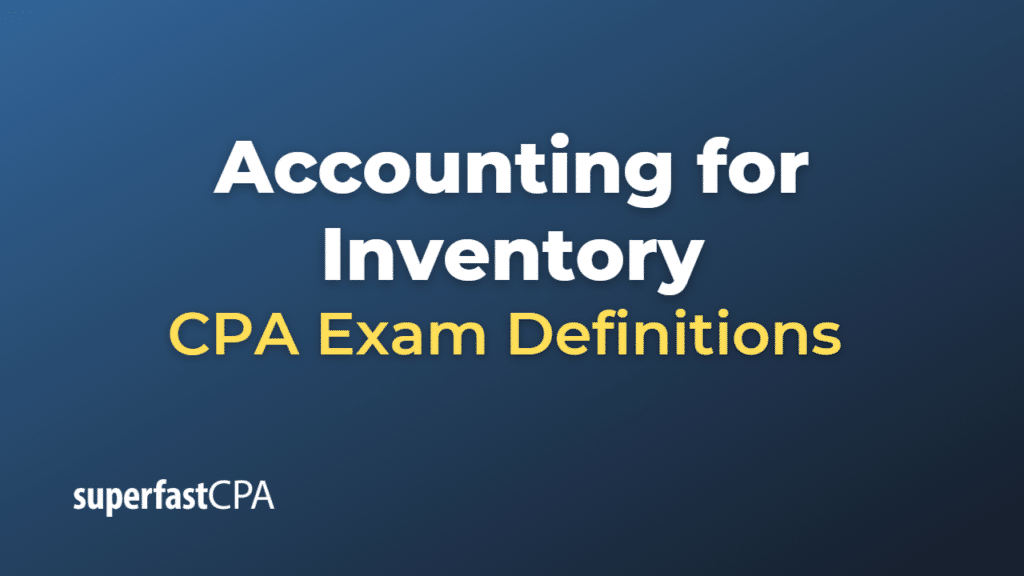Accounting for Inventory
Accounting for inventory involves the proper identification, recognition, measurement, valuation, and disclosure of inventory in a company’s financial statements. Inventory is the stock of goods or materials that a company holds for sale or uses in the production process to generate revenue. Proper inventory accounting is crucial for businesses to accurately track the cost of goods sold (COGS) and to maintain an optimal level of inventory.
Under U.S. Generally Accepted Accounting Principles (GAAP) and International Financial Reporting Standards (IFRS), inventory accounting is primarily governed by FASB’s ASC Topic 330 and IAS 2, respectively.
Here are the key aspects of accounting for inventory:
- Identification: Determine which items should be considered as inventory. Inventory typically includes finished goods, work-in-process, and raw materials.
- Recognition: Recognize inventory when the company obtains control over the goods, usually upon the transfer of ownership or receipt of the goods.
- Measurement: Inventory is initially measured at cost, which includes all costs necessary to bring the inventory to its current condition and location, such as purchase price, transportation costs, handling fees, and other directly attributable costs.
- Valuation: Inventory valuation involves determining the cost of goods sold and the value of the remaining inventory. There are several methods for inventory valuation, including:a. First-in, First-out (FIFO): Assumes that the first items purchased or produced are the first ones to be sold. The remaining inventory is valued at the most recent purchase or production costs.b. Last-in, First-out (LIFO): Assumes that the last items purchased or produced are the first ones to be sold. The remaining inventory is valued at the earliest purchase or production costs. (Note: LIFO is allowed under U.S. GAAP but not under IFRS.)c. Weighted Average Cost: Calculates the average cost of all items in inventory and uses this average to value the cost of goods sold and the remaining inventory.
- Lower of Cost or Net Realizable Value (LCNRV): Inventory must be reported at the lower of its cost or net realizable value (NRV). NRV is the estimated selling price in the ordinary course of business, less the estimated costs of completion, disposal, and transportation.
- Periodic vs. Perpetual Inventory System: Companies can use either a periodic or perpetual inventory system to track inventory and cost of goods sold:a. Periodic Inventory System: Inventory and cost of goods sold are updated at the end of the accounting period, using physical inventory counts and inventory valuation methods.b. Perpetual Inventory System: Inventory and cost of goods sold are updated continuously, using real-time inventory tracking and valuation methods.
- Disclosure: Disclose information about the inventory valuation method, the types of inventory, the carrying amounts, any write-downs, and other relevant details in the notes to the financial statements.
By properly accounting for inventory, a company provides users of its financial statements with an accurate representation of its financial position and performance, considering the value of its inventory and the related cost of goods sold.
Example of Accounting for Inventory
Let’s consider an example of a company accounting for inventory using the FIFO (First-in, First-out) valuation method under a perpetual inventory system.
Example: LMN Company sells widgets and starts the month with 100 units of inventory at a cost of $10 per unit. During the month, LMN Company purchases an additional 200 units at a cost of $12 per unit. The company sells 250 units during the month.
Here’s how LMN Company would account for the inventory and cost of goods sold:
Step 1:
Initial inventory: LMN Company starts with 100 units at a cost of $10 per unit.
| Inventory balance: 100 units x $10 = $1,000 |
Step 2:
Inventory purchase: LMN Company purchases 200 units at a cost of $12 per unit.
| Inventory balance: ($1,000 initial inventory) + (200 units x $12) = $3,400 |
Step 3:
Sales: LMN Company sells 250 units during the month. Using the FIFO method, the first 100 units sold are from the initial inventory, and the next 150 units sold are from the additional purchase.
| Cost of goods sold (COGS) calculation: |
| (100 units x $10) + (150 units x $12) = $1,000 + $1,800 = $2,800 |
Step 4:
Remaining inventory: After selling 250 units, LMN Company has 50 units remaining in inventory.
| Inventory balance: ($3,400 before sales) – ($2,800 COGS) = $600 |
Step 5:
Financial statement impact:
- The cost of goods sold of $2,800 is recognized as an expense on the income statement, reducing the company’s net income.
- The remaining inventory of $600 is reported as a current asset on the balance sheet.
By properly accounting for the inventory and cost of goods sold, LMN Company provides users of its financial statements with an accurate representation of its financial position and performance, considering the value of its inventory and the related cost of goods sold.













